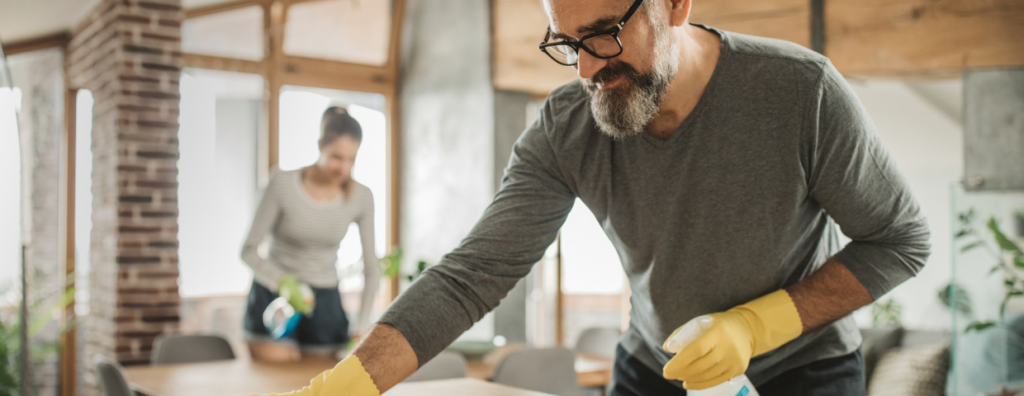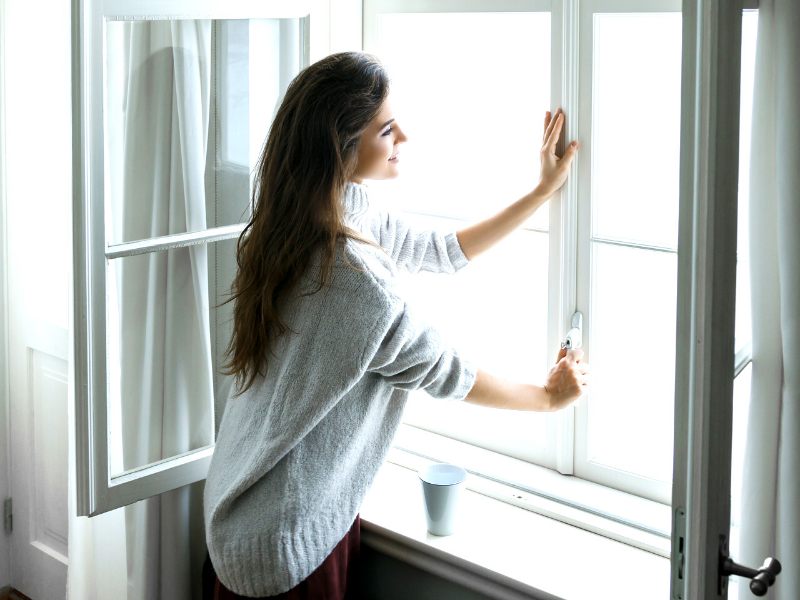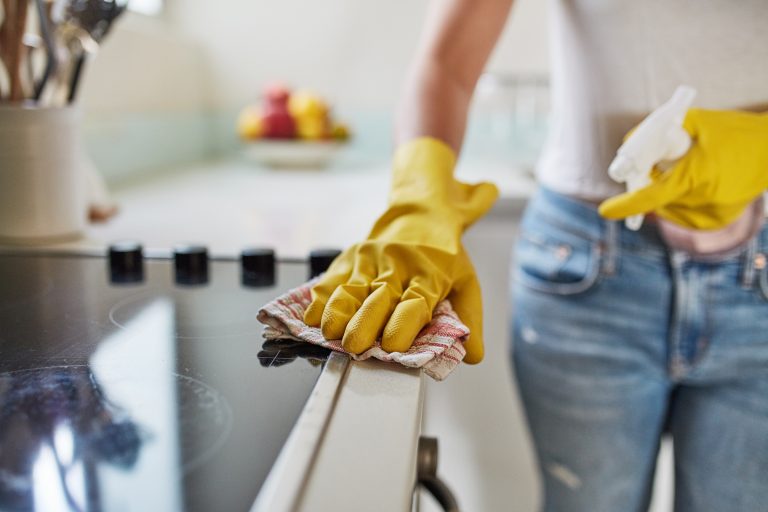6 Commonly Missed Cleaning Spots

It’s easy to get into a routine when cleaning your home season after season, year after year. While simply going over the same spots may make your home feel cleaner, at the same time, it allows the neglected areas to become dirtier. Here are six commonly missed spots around the home that, once given the attention they deserve, will help make your home feel completely clean.
6 Commonly Missed Cleaning Spots
1. Underneath & Behind Furniture
Dirt and dust love to hide in tough-to-reach, tucked-away spots like behind your nightstand, under your bed frame, and on the underside of your tables, chairs, and couches. Cleaning these areas may require some heavy lifting and rearranging but it’s worth your while. If enough dust and grime have accumulated over the years that your vacuum can’t remove the buildup, try using a washcloth to loosen the sediment.
2. Vents and Fans
Vents and fans not only collect dust, but they also distribute it around your home. Ceiling fans are one of the hardest spots in your home to reach, so you may need to use a ladder and an extended duster to clean them. Clean your vent grates with a dusting brush or a wire brush depending on the thickness of the buildup. If your home has central air, remember to replace your air filters periodically. A clean ventilation system is key to protecting your home’s air quality.
3. Bathroom Surfaces
We all know the feeling of picking up a rarely used shampoo bottle in the shower to discover a grimy ring underneath it. Wipe off your bottles and surfaces in the shower to keep it sparkling clean. Scrub away the debris from your shower head and soak it in a mixture of water and white vinegar to cleanse the device and to prevent a buildup of mineral deposits. To reach behind the toilet, you may need knee pads and an extended cleaning tool. Use a disinfectant-water mixture to prevent the spread of germs. Tackling chores like these will help make your bathroom feel brand new in no time.
4. Switches & Handles
Light switches, door handles, drawer pulls, and knobs are all hotbeds for germs and dirt and can easily be forgotten while cleaning your home. Take a two-step approach to cleaning these high-touch surfaces: first clean, then disinfect. Cleaning will get rid of contaminants, while disinfecting targets pathogens. The combination of the two will help make your home feel cleaner while reducing the spread of germs. Other high-touch surfaces such as keyboards, phones, tablets, and other devices require regular cleaning as well.
5. Appliances
It’s easy to think of your appliances strictly as devices that help your home stay clean and organized, but they are magnets for dirt and gunk, too. After cleaning out the refrigerator and scrubbing down the shelves, find the coils and clean them of debris with a vacuum or a brush. The floor underneath your refrigerator can be a seriously grimy spot, so a quick mop of that area is worth your while. Give your dishwasher a good cleanse to prevent mold buildup and bad odors. Remember to clean out the filter occasionally with soap and water. Cleaning your appliances routinely can help avoid repairs and can even extend their life expectancy.
6. Baseboards
Baseboards are the perfect settling point for dirt and dust. The space between your walls and floors is an easy trap for buildup, and upon closer inspection, you’ll find some combination of scuffs, dust, food remnants and scratch marks. To thoroughly clean your baseboards, you may need to move your furniture away from the walls but be careful not to scratch the floor or damage the baseboards. Wipe away the dust before cleaning the surface. Use either a mix of soap and water, water and vinegar, or the proper wood cleaner for wooden baseboards.
Protecting Your Home’s Air Quality

Image Source: Canva
Most of us tend to think of air pollution as something that occurs outdoors where car exhaust and factory fumes proliferate, but there’s such a thing as indoor air pollution, too. Since the 1950s, the number of synthetic chemicals used in home products have increased drastically, while homes have become much tighter and better insulated. As a result, the EPA estimates that Americans, on average, spend approximately 90 percent of their time indoors, where the concentrations of some pollutants are often two to five times higher than typical outdoor concentrations.
Luckily, there are many ways to reduce indoor air pollution. We all know that buying organic and natural home materials and cleaning supplies can improve the air quality in our homes, but there are several other measures you can take as well.
How pollutants get into our homes
Potentially toxic ingredients are found in many materials throughout the home, and they leach out into the air as Volatile Organic Compounds, or VOCs. If you open a can of paint, you can probably smell those VOCs. Mold is a VOC that can build up in the dampest parts of your home like the laundry room or crawl spaces. Another example is the “new car smell” that seems to dissipate after a while, but VOCs can “off-gas” for a long time, even after a noticeable smell is gone.
Many materials used to build a home contain chemicals like formaldehyde, toluene, xylene, ethanol, and acetone, and even lead. VOCs can also be in the form of pet dander or dust. Fortunately, VOCs from building materials dissipate over time. For that reason, the highest levels of VOCs are usually found in new homes or remodels. If you are concerned about VOCs, there are several products you can buy that are either low- or no-VOC. You can also have your home professionally tested.
How to reduce VOCs in your home
Choose your building materials wisely
- – Use tile or solid wood for flooring—hardwood, bamboo, or cork
- – Choose solid wood or outdoor-quality plywood that uses a less toxic form of formaldehyde.
- – Choose low-VOC or VOC-free paints and finishes
Purify the air
- – Make sure your rooms have adequate ventilation, air out newly renovated areas for at least a week
- – Clean ductwork and furnace filters regularly
- – Install air cleaners if needed
- – Use only environmentally responsible cleaning chemicals
- – Plants are a natural solution to help clean the air
- – Air out freshly dry-cleaned clothes or choose a “green” cleaner
Pick the right carpet
- – Choose “Green Label” carpeting or a natural fiber such as wool or sisal
- – Use nails instead of glue to secure carpet
- – Install carpet LAST after completing painting projects or wall coverings
- – Air out newly carpeted areas before using
- – Use a HEPA vacuum or a central vac system that vents outdoors
Prevent mold
- – Clean up water leaks fast
- – Keep humidity below 60 percent, using dehumidifiers if necessary
- – Refrain from carpeting rooms that stay damp
- – Insulate pipes, crawl spaces, and windows to eliminate condensation
- – Use one-half cup of bleach per gallon of water to kill mold in its early stages
If you would like to learn more about VOCs and indoor air quality, please visit http://www.epa.gov/iaq/.
Simple Steps for Maintaining Air Quality in Your Home

Posted in Living by Kenady Swan

Most of us tend to think of air pollution as something that occurs outdoors where car exhaust and factory fumes proliferate, but there’s such a thing as indoor air pollution, too. Since the 1950s, the number of synthetic chemicals used in products for the home has increased drastically, while at the same time, homes have become much tighter and better insulated. As a result, the EPA estimates that indoor pollutants today are anywhere from five to 70 times higher than pollutants in outside air.
Luckily, there are many ways to reduce indoor air pollution. We all know that buying organic and natural home materials and cleaning supplies can improve the air quality in our homes, but there are several other measures you can take as well.
How pollutants get into our homes
Potentially toxic ingredients are found in many materials throughout the home, and they leach out into the air as Volatile Organic Compounds or VOCs. If you open a can of paint, you can probably smell those VOCs. The “new car smell” is another example of this. The smell seems to dissipate after a while, but VOCs can actually “off-gas” for a long time, even after a noticeable smell is gone.
We all know to use paint and glue in a well-ventilated room, but there are many other materials that don’t come with that warning. For instance, there are chemicals, such as formaldehyde, in the resin used to make most cabinets and plywood particle board. It’s also in wall paneling and closet shelves, and in certain wood finishes used on cabinets and furniture. The problems aren’t just with wood, either. Fabrics—everything from draperies to upholstery, bedding, and carpets—are a potent source of VOCs.
The good news about VOCs is that they do dissipate with time. For that reason, the highest levels of VOCs are usually found in new homes or remodels. If you are concerned about VOCs, there are several products you can buy that are either low- or no-VOC. You can also have your home professionally tested.
How to reduce VOCs in your home
Make smart choices in building materials.
- For floors, use tile or solid wood—hardwood, bamboo, or cork – instead of composites.
- Instead of using pressed particle board or indoor plywood, choose solid wood or outdoor-quality plywood that uses a less toxic form of formaldehyde.
- Choose low-VOC or VOC-free paints and finishes.
Purify the air that’s there.
- Make sure your rooms have adequate ventilation, and air out newly renovated or refurnished areas for at least a week, if possible.
- Clean ductwork and furnace filters regularly.
- Install air cleaners if needed.
- Use only environmentally responsible cleaning chemicals.
- Plants can help clean the air: good nonpoisonous options include bamboo palm, lady palm, parlor palm, and moth orchids.
- Air out freshly dry-cleaned clothes or choose a “green” cleaner.
Fight the carpet demons.
- Choose “Green Label” carpeting or a natural fiber such as wool or sisal.
- Use nails instead of glue to secure carpet.
- Install carpet LAST after completing painting projects, wall coverings, and other high-VOC processes.
- Air out newly carpeted areas before using.
- Use a HEPA vacuum or a central vac system that vents outdoors.
Prevent Mold.
- Clean up water leaks fast.
- Use dehumidifiers, if necessary, to keep humidity below 60 percent.
- Don’t carpet rooms that stay damp.
- Insulate pipes, crawl spaces, and windows to eliminate condensation.
- Kill mold before it gets a grip with one-half cup of bleach per gallon of water.
We hope this information is helpful. If you would like to learn more about VOCs and indoor air quality, please visit http://www.epa.gov/iaq/.
 Facebook
Facebook
 Twitter
Twitter
 Pinterest
Pinterest
 Copy Link
Copy Link

